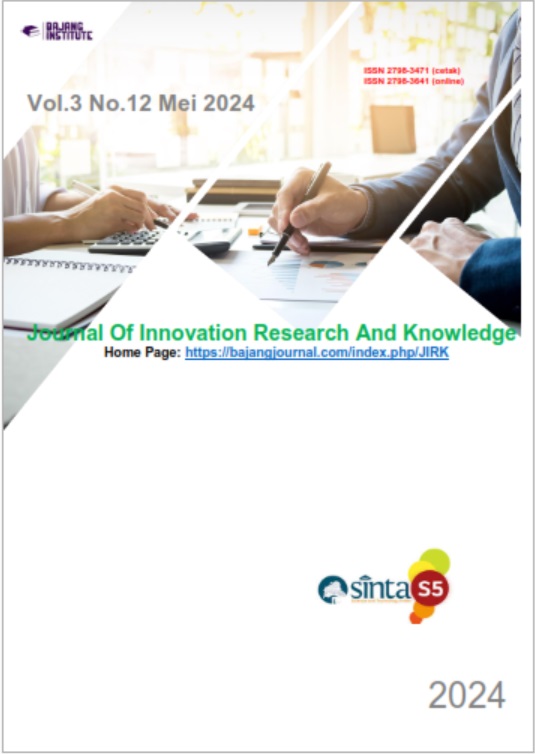HUBUNGAN ARCUS PEDIS DENGAN KESEIMBANGAN STATIS PADA ANAK USIA 9-12 TAHUN DI SDN GONILAN 02
DOI:
https://doi.org/10.53625/jirk.v3i12.7744Keywords:
Arcus pedis shape, Arcus pedis shape, Static Balance, Static Balance, aged 9-12 years, aged 9-12 yearsAbstract
Background: the ability of children to be able to perform physical activities in a coordinated manner is needed to support and support physical activities so as to improve their achievements. Therefore, in childhood, physical development must always be paid attention to, especially in the development of the arcus pedis, because in childhood if the arcus pedis of children who do not grow normally will be able to cause several disorders, one of which disorders that can occur is balance disorders, while balance is a very vital body function for humans as well as the five senses. Objective: The purpose of this study was to determine whether there is a relationship between arcus pedis and static balance in children aged 9-12 years at Gonilan 02 Elementary School. Method: this study used a cross sectional study design method, the sample size was 84 children with purposive sampling technique and random samples (randbetween), using the Kolmogorov-smirnov normality test and the spearment rho test. Results: esults: from the results of the study from the Spearmen's rho test of the arcus pedis with static balance, a significant value of p = 0.017> 0.05 was obtained so that it could be concluded that there was a relationship between the arcus pedis and static balance for a value of r = 0.260 which means that the level of relationship is weak and the data is positive, where the arcus pedis has increased, the static balance has increased. Conclusion: Based on the results of the research that has been done, it shows that there is a relationship between arcus pedis and static balance in children aged 9-12 years at Gonilan 02 Elementary School.
References
Afafah, M. N. F., & Kumaat, N. A. (2018). Analisis Keseimbangan Statis Dan
Keseimbangan Dinamis Wanita Paguyuban Olahraga Lansia Perumahan
Pongangan Indah Gresik. Jurnal Kesehatan Olahraga Ikor Fio Unesa, 2(7),
-298.https://ejournal.unesa.ac.id/index.php/jurnal-kesehatan olahraga /
article/view/25124
Arachchige, S.N.K, Chander, H., & Knight, A. (2019). Flatfeet: Implikasi
biomekanik, penilaian dan manajemen. Kaki, 38, 81-85.
https://doi.org/10.1016/j.foot.2019.02.004
Benedetti, M. G., Ceccarelli, F., Berti, L., Luciani, D., Catani, F., Boschi, M., &
Giannini, S. (2011). Diagnosis of flexible flatfoot in children: a systematic
clinical approach. Orthopedics, 34(2). https://doi.org/10.3928/01477447-
-04
Dabholkar, T., & Agarwal, A. (2020). Quality of life in adult population with flat
feet. International Journal of Health Sciences and Research, 10(8).
Dewi, K. G. P., Dewi, A. A. N. T. N., Antari, N. K. A. J., & Indrayani, A. W. (2020).
Perbedaan Gait Parameter Terhadap Tipe Arkus Pedis (Normal Foot, Flat Foot Dan Cavus Foot) Pada Anak Sekolah Dasar Usia 10-12 Tahun Di Denpasar Barat. Majalah Ilmiah Fisioterapi Indonesia, 8(2), 57-61.
https://ojs.unud.ac.id/index.php/mifi/article /50303/35418
Hegazy, F., Aboelnasr, E., Abuzaid, M., Kim, I. J., & Salem, Y. (2021). Comparing
validity and diagnostic accuracy of clarke’s angle and foot posture index-6 to
determine flexible flatfoot in adolescents: A cross-sectional
investigation. Journal of Multidisciplinary Healthcare, 2705-2717.
https://www.tandfonline.com/doi/full/10.2147/JMDH.S317439
Idris, F. H. 2010. Filogeni dan Ontologi Lengkung Kaki Manusia. Jakarta:
Departemen Kedokteran Fisik dan Rehabilitasi Medik, Fakultas Kedokteran
Universitas Indonesia/Rumah Sakit Dr. Cipto Mangunkusumo. Vol 60 (2): 74-
Latifah, Y., Naufal, A. F., Nafi'ah, D., & Astari, R. W. (2021). Hubungan Antara
Postur Flat Foot Dengan Keseimbangan Statis Pada Anak Usia 12 Tahun. fisio
mu: Physiotherapy Evidences, 2(1), 1-6. https://journals.ums.ac.id/index.php/fisiomu/article/view/10039
Lendra, M. D., & Santoso T.B, . (2009). Beda Pengaruh Kondisi Kaki Datar dan
Kaki Dengan Arkus Normal Terhadap Keseimbangan Statis Pada Anak Usia
–12 Tahun di Kelurahan Karangasem, Surakarta. Jurnal Ilmiah
Fisioterapi, 9(2),
Medina, N. (2023). Hubungan Bentuk Arcus Pedis Berdasarkan Footprint Test
dengan Nilai VO2 Max [Universitas Muhammadiyah Sumatera Utara].
http://repository.umsu.ac.id/bitstream/handle/123456789/21464/naura
Mardiah, A., & Sari, M. (2022). Pemeriksaan Arcus Pedis. Empowering Society
Journal, 2(3). https://ojs.fdk.ac.id/index.php/ESJ/article/view/1522
Nugroho, A. S., & Nurulita, F. F. (2019). Hubungan antara pes planus dengan
keseimbangan dinamis pada murid MI Nurul Karim Colomadu. Jurnal
Keterapian Fisik, 4(1), 6-14. https://doi.org/10.37341/jkf.v4i1.120
Pita-Fernandez, S., Gonzalez-Martin, C., Seoane-Pillado, T., Lopez-Calvino, B.,
Pertega-Diaz, S., & Gil-Guillen, V. (2015). Validitas analisis tapak kaki untuk
menentukan kelasi menggunakan diagnosis klinis sebagai gold standard pada
sampel acak berusia 40 tahun ke atas. Jurnal epidemiologi, 25 (2), 148-154.
https://doi.org/10.2188/jea.JE20140082
Pristianto, A., Azizah, H. N., & Maharrani, D. (2024). Edukasi Perkembangan
Arcus Pedis Pada Anak Sebagai Pencegahan Kelainan Postur Telapak
Kaki. Abdi Masyarakat Vokasi, 1(1), 67-72.
https://amarasi.flmunhanri.org/index.php/amarasi/article/view/17
Risangdiptya, G., & Ambarwati, E. (2016). Perbedaan Antara Keseimbangan Tubuh
Sebelum Dan Sesudah Senam Pilates Pada Wanita Usia Muda. Jurnal
Kedokteran Diponegoro (Diponegoro Medical Journal), 5(4), 911-916.
https://ejournal3.undip.ac.id/index.php/medico/article/view/14452
Sari, S. (2013). Peranan Gender dalam mempertahankan keseimbangan statis dan
dinamis pada Mahasiswa STKIP PGRI Pontianak. Jurnal Pendidikan Olah
Raga, 2(2), 195-203. https://doi.org/10.31571/jpo.v2i2.237
Setyaningrahayu, F., Rahmanto, S., & Multazam, A. (2020). Hubungan Kejadian
Flat Foot Terhadap Keseimbangan Dinamis Pada Pelajar Di Sman 3
Malang. Physiotherapy Health Science, 2(2), 83-89.
Sihombing, D. P., Fiana, D. N., Wahyuni, A., & Fauzi, A. (2022). Hubungan Antara
Arcus Pedis dengan Q-Angle dan Keseimbangan Pada Lansia di Panti Tresna
Werdha Natar. Jurnal Agromedicine, 9(2), 92-100.
Syafi’i, M., & Pudjiastuti, S. S. (2016). Beda Pengaruh Arkus Kaki terhadap
Keseimbangan Statis Anak Usia 9-12 Tahun di SD Negeri Mojolegi, Teras,
Boyolali. Jurnal Kesehatan, 7(3), 351-354.
http://dx.doi.org/10.26630/jk.v7i3.215
Yasmasitha, Z., & Sidarta, N. (2020). Hubungan pes planus dan keseimbangan statis
pada anak sekolah dasar. Jurnal Biomedika Dan Kesehatan, 3(2), 84-89.













